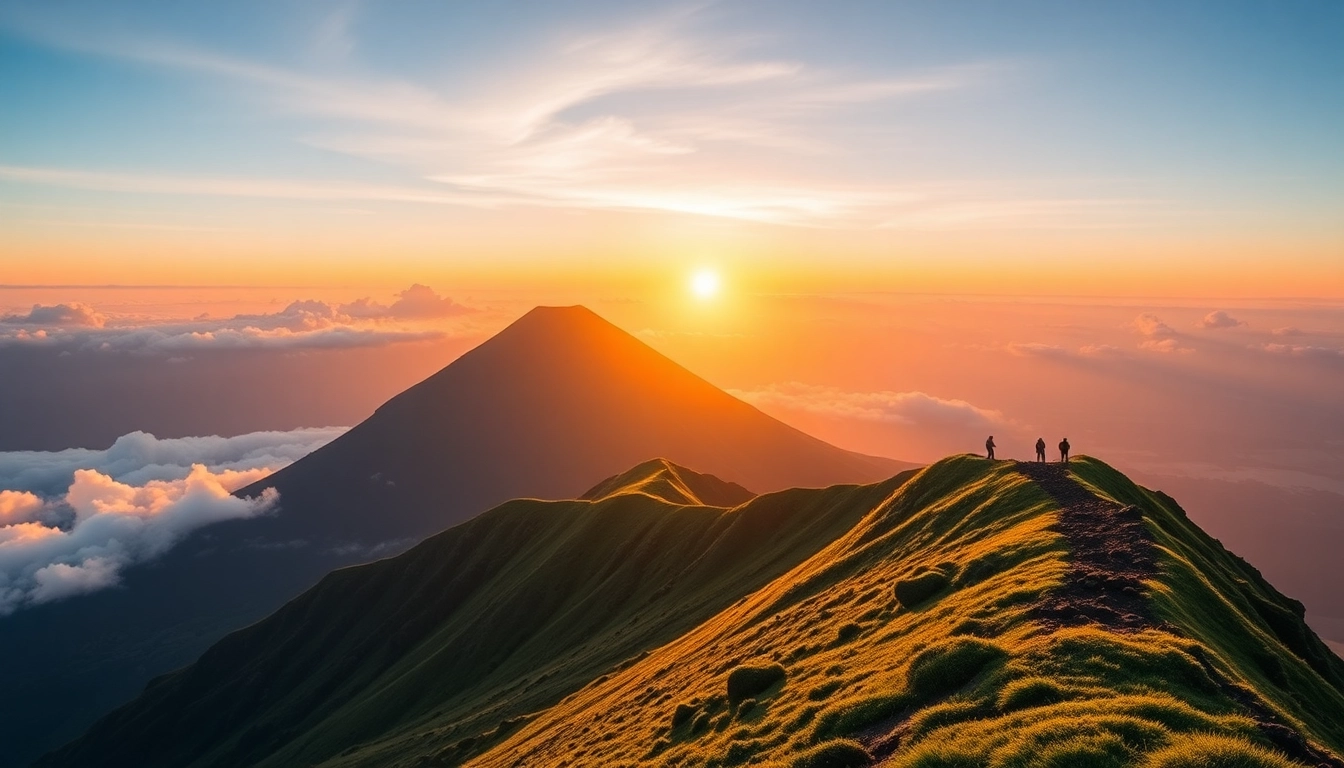
Introduction to Mount Rinjani and Its Significance
Nestled on the island of Lombok in Indonesia, Mount Rinjani stands as one of Southeast Asia’s most majestic and revered volcanic landmarks. As the second-highest volcano in Indonesia, Rinjani holds a prominent place not only in the geography of Lombok but also in the cultural, ecological, and geological tapestry of the region. Its prominence as an active volcano with a storied history and breathtaking landscapes makes it a magnet for adventurers, nature enthusiasts, and cultural explorers alike.
This comprehensive guide aims to delve into every aspect of Mount Rinjani, from its geographical features and ecological significance to its cultural importance and practical travel tips. Whether you’re seeking the thrill of summiting a formidable volcanic peak or interested in immersing yourself in Lombok’s rich traditions, understanding Rinjani’s multifaceted identity is essential. For travelers and trekkers, it is not just a mountain but a symbol of resilience, natural beauty, and Indonesia’s volcanic heritage.
Geographical location and physical features
Mount Rinjani is situated in North Lombok Regency, within Rinjani National Park, covering an area of approximately 41,330 hectares. Characterized by its imposing stature, the volcano rises to an elevation of 3,726 meters (12,224 feet), making it the second-highest peak in Indonesia after Kerinci. Its geographical location in the Wallacea biogeographical zone results in a unique junction where Asian and Australasian flora and fauna converge, creating a diverse and vibrant ecosystem.
The volcano features a symmetrical cone with a prominent caldera — approximately 8 km wide — that hosts Segara Anak, a stunning crater lake that remains hot due to the volcano’s ongoing activity. The volcanic landscape also includes steaming vents, hot springs, and surrounding lush forests, reflecting its status as an active volcano with periodic eruptions. The terrain varies from rocky summit ridges to verdant slopes rich with biodiversity, offering diverse sights for hikers and nature lovers.
Historical and cultural importance in Lombok
Mount Rinjani is deeply woven into Lombok’s cultural fabric and spiritual life. Historically, the mountain is believed to be sacred, often associated with mythologies and local legends. It is considered the dwelling place of the gods and the spiritual center for the Sasak and Balinese communities inhabiting Lombok. Ancient rituals and ceremonies often take place in the shadow of Rinjani, emphasizing its divine status.
The volcano’s history is equally compelling. The most notable eruption was around the year 1257, originating from the eruption of the Samalas volcano, which significantly influenced global climate through its massive ash clouds. This eruption altered local landscapes and affected surrounding communities dramatically. Today, Rinjani is a symbol of resilience, with local stories intertwining geology with cultural mythology — highlighting humanity’s respect and reverence for this powerful natural force.
Unique biodiversity within Rinjani National Park
Rinjani National Park stands as a biodiversity hotspot, boasting a wide array of flora and fauna unique to this ecotone. The park’s elevation gradient, from lowland forests to alpine zones near the summit, supports an ecological diversity that is crucial for conservation. Some endemic species include the translucent Javan spinner dolphin, various orchids, and rare bird species such as the Flores hawk-eagle.
The park is also home to several medicinal plants and vital pollinators, underpinning local livelihoods and traditional medicine. Conservation efforts are vital to preserving these species amidst increasing tourism and environmental pressures. Visitors are encouraged to respect the natural habitat by adhering to designated trails, avoiding littering, and supporting local initiatives that promote sustainable tourism.
Guides to Trekking Mount Rinjani
Popular trekking routes and difficulty levels
Trekking Mount Rinjani offers several routes, each with distinct challenges and scenic rewards. The most popular and accessible trek is the Sembalun Line, known for its gentle slopes, panoramic vistas, and strategic starting point in Sembalun Lawang village. This route generally takes about 3-4 days for experienced trekkers. Alternatively, the Senaru route provides a more challenging ascent with dense forest trails and steep inclines, suitable for seasoned hikers.
The trek difficulty varies from moderate to strenuous, with elevation gain, unpredictable weather, and volcanic terrain adding to the challenge. Trekkers must be prepared physically and mentally for altitude sickness, dehydration, and terrain difficulties. Proper acclimatization and training are recommended before embarking on the journey.
Essential preparation and safety tips
Preparing for a Mount Rinjani trek involves securing the right gear, sufficient supplies, and a clear understanding of the route. Essential items include sturdy hiking boots, warm layered clothing, rain gear, headlamps, and a first-aid kit. Altitude acclimatization is crucial, so gradual exposure or pre-trekking training is advisable.
Safety tips include trekking with experienced guides, informing others of your plans, and adhering to park regulations. It is imperative to be aware of weather updates, as conditions can change rapidly, with thunderstorms and cold temperatures at higher elevations. Emergency evacuation plans and hiring local guides can significantly enhance safety.
Guided tours and local operators
Several reputable tour operators and guides in Lombok specialize in Mount Rinjani expeditions, offering package treks that include transportation, accommodation, permits, and experienced guides. These operators ensure safety, logistics management, and ecological responsibility. Choosing an accredited operator supports local communities and promotes sustainable tourism practices.
For detailed information and booking options, prospective trekkers can visit the official Rinjani National Park website or trusted local agencies. It is recommended to compare packages, reviews, and inclusions to select the best option tailored to your skill level and objectives.
Best Times to Visit and Planning Your Trip
Optimal seasons for trekking and sightseeing
The ideal period for trekking Mount Rinjani falls within the dry season from April to October. During these months, the weather tends to be clear, with minimal rainfall, making trekking safer and more manageable. The peak months—July and August—attract the most visitors, but early mornings and late afternoons offer the most stunning lighting for photography and sightseeing.
Weather considerations and important dates
Rainy seasons, from November to March, pose challenges such as slippery trails, increased risk of landslides, and poor visibility. Sudden weather changes can occur even during the dry season, so travelers must prepare for cold nights at higher elevations and potential thunderstorms. Major festivals in Lombok, such as the Bau Nyale sea worm festival, provide cultural experiences but do not significantly impact trekking schedules.
Travel logistics and accommodation options
Reaching Lombok typically involves flights to Lombok International Airport. From there, travelers can arrange transportation to Sembalun or Senaru villages, gateways for trek initiation. Accommodation options range from traditional guesthouses and homestays to eco-lodges near the park entrance. For a more immersive experience, some trekkers opt for camping or staying in local villages, supporting community-based tourism.
Experiencing the Beauty of Mount Rinjani
Scenic viewpoints and photographic spots
The journey up Rinjani offers numerous vantage points that captivate photographers and nature lovers alike. The view from Summit Point offers sweeping vistas of the surrounding islands, neighboring mountains, and the crater lake of Segara Anak—its emerald waters set against the black volcanic terrain. Sunrise and sunset over the caldera are particularly mesmerizing, making early mornings a highlight for visitors.
Unique attractions within the national park
Beyond the summit, attractions include the hot springs of Pemandian Air Panas, where visitors can relax in mineral-rich waters. The waterfalls around Rinjani, such as the Sendang Gile and Tiu Kelep, provide tranquil breaks amid climbing. The vibrant flora and fauna, along with volcanic landscapes, create a dynamic and ever-changing scenery that reflects the Earth’s geothermal activity.
Local culture and community interactions
Engaging with local communities enriches the Rinjani experience. Visiting traditional Sasak villages offers insights into Lombok’s cultural heritage, crafts, and religious practices. Many community-led initiatives promote responsible tourism, including guided cultural tours, cooking classes, and village homestays. Supporting these endeavors helps preserve local traditions and uplifts community livelihoods.
Environmental Preservation and Sustainable Tourism
Conservation efforts and responsible trekking
The authorities and local NGOs actively promote conservation initiatives, including park patrols, reforestation, and waste management programs. Trekkers are urged to follow Leave No Trace principles: packing out all trash, using designated paths, and avoiding harm to wildlife and vegetation. Permits are required for trekking, which contribute to funding conservation projects.
Impact of tourism on Rinjani’s ecosystem
While tourism provides economic benefits, unmanaged influxes can threaten the fragile ecosystems of Rinjani. Littering, trail erosion, and careless camping practices can degrade natural habitats. Uncontrolled development and increased visitor numbers necessitate stricter regulations and community involvement to maintain ecological integrity.
How visitors can support sustainability initiatives
Visitors can make a positive impact by choosing eco-friendly tour operators, respecting local customs, and participating in educational programs. Opting for minimal-impact camping, avoiding single-use plastics, and financially supporting community-based projects help ensure Rinjani remains a pristine and vibrant natural wonder for future generations.




